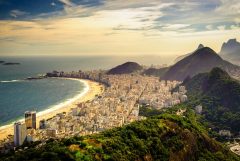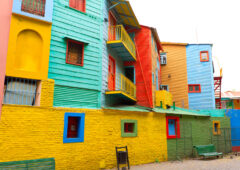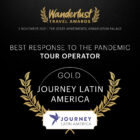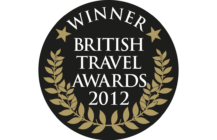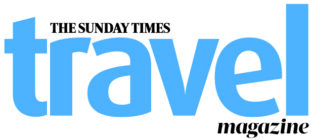Private Journeys
Luxury Rio, Iguazu Falls, Buenos Aires and the pampas
11 days from £7,680pp
(based on two people sharing & excluding flights)
Essentials
-
Tour info
-
Country info
-
What's included
Tour info
Transport
2 flights (each 2 hrs); 2 road transfers (longest 2 hrs).
Accommodation
For this holiday however we have chosen the very best hotels available in each location. The Belmond Copacabana Palace and Das Cataratas hotels both have superlative locations which could not be bettered: the Cataratas is the only property overlooking the falls on the Brazilian side. The Alvear Palace is a magnificent traditional property heaving with nostalgia. The facilities and service at all properties are, of course, top of the range. Your ranch in the Pampas, la Bamba, offers the very best in service and facilities.
Meals
Breakfast daily, lunch day 2; dinner day 8; full board days 9,10.
Guides
We carefully select our local partners, some of whom we have worked with for over 30 years. Their English-speaking guides understand the expectations of our clients very well, and are consistently singled out for praise by the latter on their return.
Summary Of Nights
11 days, 10 nights: Rio de Janeiro 3; Iguazú 2; Buenos Aires 3, estancia 2.
Optional Excursions
There are a number of half, full-day or longer excursions or activities you may wish to consider in order to customise your holiday to cater for your interests. Please contact us to discuss these further or to add them to your itinerary before you depart. A selection of these include:
• Samba show, Rio de Janeiro.
• Schooner trip to the Tropical islands on the Emerald Coast.
• Helicopter ride over Iguazú falls.
Currency
The unit of currency in Brazil is the ‘real’ (plural reais); in Argentina it is the Argentine peso.
How To Take It
Cash machines are available in all major cities and towns, and so taking a debit or credit card with a PIN number is the most convenient way of withdrawing money while on your trip, and in most shops and restaurants you can also pay by card. However, since cards can get lost, damaged, withheld or blocked, you should not rely exclusively on a card to access funds.
We recommend that additionally you take a reasonable quantity of US dollars cash (no more than is covered by your insurance), which you can exchange into local currency. Dollar bills should be in good condition, soiled or torn bills may be refused. You can take sterling, but the exchange rate is not always competitive or even available, restricting the number of places where you can change money.
For our latest currency advice for Argentina please see our FAQs section.
Tipping
Tips are expected and local guides often rely on their tip as a significant proportion of their income.
Most service industry workers will expect a tip of some kind and so it is useful to have spare change for hotel porters, taxi drivers and the like. It is common to leave 10 – 12% in restaurants.
Insurance
Travel insurance is essential.
Details of our recommended policy can be found on our Travel Insurance page.
Airport Taxes
If you have purchased your flights through Journey Latin America, the international departure tax is usually included in the ticket.
Trip Suitability
There are no long days of travel on this trip. There are two domestic flights by commercial jet.
This holiday is suitable for all but if you have a disability or other special requirements, please call us.
In the summer months of December to March the weather is extremely hot and humid, you might bear this in mind if travelling with small children or elderly persons.
Climate
In Rio, Buenos Aires, Iguazú and the pampas, December to March are the hottest and most humid months, with temperatures sometimes reaching 40°C, and rain which falls in brief, heavy showers.
From June to September, temperatures are more moderate (18-23°C) and there is plenty of sunshine, but cold fronts can usher in periods of up to several days of cloud and drizzle.
Clothing And Special Equipment
In the southern summer, for day-to-day wear you should take loose-fitting, breathable clothes. Comfortable shoes and sandals are advisable. A sun hat, sun block and sunglasses are necessary, and you should take a light fleece or jacket for cool nights, and a waterproof jacket and/or umbrella. You might like to bring binoculars for wildlife spotting at the estancia. Brazil is an informal country but if you plan to go to good restaurants or out on evening entertainment trips, you might want to bring something smart as well.
At the Iguazú Falls you can get very wet from the spray. You may wish to take dry clothes in a dry bag.
Please get in touch with the office before departure if you have any doubts. Good equipment is very important and hard to come by in South America.
Vaccinations
Preventative vaccinations are recommended against the following; typhoid; polio; tetanus; hepatitis A. For specific requirements you must consult your GP.
As of 2018, visitors to Brazil travelling on our holidays should be protected with a vaccination against yellow fever, and carry the corresponding certificate. In April 2013, the World Health Organisation Strategic Advisory Group of Experts on Immunisation concluded that a single primary dose of yellow fever vaccine is sufficient to confer sustained immunity and lifelong protection against yellow fever disease, and that a booster dose is not needed.
You can also find helpful information on the Masta Travel Health website.
Visas
Holders of a full British passport do not require a visa, although passports must be valid for at least 6 months after the trip begins. Anyone with a different nationality should enquire with us or check with the relevant consulate.
If flying to the US, or via the US you will need to fill in your online ESTA application.
Country info
When's the best time to visit Brazil?
Brazil is an all-year destination, but it’s a vast country: when you go will depend on your chosen itinerary and interests. Late Dec-Mar are the hottest months – very hot (over 40°C) from Rio northwards – and the local holiday season, so attractions can be very busy. During the Amazon’s wet season (Jan - Jun) it’s easier to get round by boat, the dry season is sunnier and better for wildlife-spotting but very hot. The Pantanal may be best avoided during the wettest months (Nov - Mar) when there are many mosquitoes. However this is the best time to visit the beaches of the south where it’s cool outside this period.
For more detailed information visit our When To Go section.
What's the official language of Brazil?
The official language of Brazil is Brazilian Portuguese; a more languid and musical version of Portugal's mother tongue. You will also find indigenous languages spoken in Amazonia.
How do I get local currency in Brazil?
The local currency in Brazil is the Brazilian Real. Notes can be withdrawn from the many ATMs at airports and in larger towns and cities. Limits may be lower than your UK bank allows. Banco do Brasil, HSBC accept UK credit or debit cards allowing daily withdrawals of 1,000reais. Bradesco allows a lower limit. Other banks eg Banco 24horas do not accept foreign cards. Most towns have a Banco do Brasil. ATMs close at 10pm. Currency is also obtainable in banks and money exchanges.
What is the time difference between Brazil and UK?
The time difference between the UK and Brazil is GMT -3 hours. There is daylight saving from Oct- end Feb (approx) when clocks are put forward one hour.
Do I need a visa for Brazil?
Holders of a full British passport do not require a visa, although passports must be valid for at least 6 months after the trip begins. Anyone with a different nationality should enquire with us or check with the relevant consulate.
If flying to the US, or via the US you will need to fill in your online ESTA application.
What vaccinations do I need for Brazil?
Please check Travel Health Pro for information on health recommendations and vaccinations for the destinations you are visiting. Please note that many Latin American countries require proof of vaccination against Yellow Fever if you have recently travelled to another country where Yellow Fever is present.
What are the festivals, cultural and sport events in Brazil?
Carnival offers 5 days of celebration in Feb/Mar. Live bands, costume balls, over-indulgence and general frivolity will take place in towns and cities all over the country. The best parades are in Rio, Salvador and Olinda.
Which countries combine well with Brazil?
Argentina: The crossing at Iguazú Falls is convenient for many visitors.
Peru: There is a direct flight from Lima to Rio de Janeiro (5 hours) and to São Paulo (4-5 hours with many connections to other cities).
When is the best time to visit Argentina?
Argentina is so large it’s always a good time to go somewhere. The southern hemisphere summer is the reverse of our own, with Dec-Feb being high summer in Patagonia. Spring (Oct-Nov) and Autumn (Mar-Apr) can still be very pleasant and are quieter. While summers in the lake district are reliably warm and sunny, the further south in Patagonia you go the more unpredictable the weather. In Winter (June-Sept) some hotels in Patagonia close, while others stay open for skiers. Buenos Aires, Mendoza and Córdoba enjoy a Mediterranean-type climate, with cool winters and very warm summers. North-west Argentina (Salta and Jujuy) enjoy sunshine and warm temperatures year-round but are influenced by altitude and the high Andes, with occasional cold snaps (June-Sept) and a rainy season (Jan-Feb). Iguazú Falls and Misiones has a subtropical climate, although it can be chilly July-Sept.
For more detailed information visit our When To Go section.
What is the official language of Argentina?
The official language of Argentina is Spanish.
What is Argentina's official currency?
The official currency of Argentina is the Argentine Peso.
Although cards have become more widely accepted, cash remains useful in Argentina so don’t rely solely on your cards. Taking funds in a mix of formats (a supply of US$ cash to convert into Pesos locally, along with your cards) is a sensible plan. In Buenos Aires and main tourist hubs you should have few problems paying by card but in more remote areas often only cash is accepted. You’ll also need cash for tips (eg if you pay for a restaurant meal with a card, tips are always left in cash). When changing money, denominations of US$50 and US$100 are usually preferred and you should make sure your notes are in perfect condition. Although ATMs are available, local ATM fees are high and the amount you can take out is lower than in the UK. We tend to avoid them.
We think it’s a good idea to keep an eye on Argentina’s exchange rates before you go. In addition to the official (BNA) rate of exchange for converting your US Dollars to Pesos, Argentina also uses a parallel exchange rate for foreign tourists (MEP). This is about 15% better than the official rate. Some casas de cambio will automatically apply the better tourist rate when changing your money. Others will only apply the official (BNA) rate. Rates used to process credit/debit card transactions can vary between card issuers, but you should find you get something between the official and tourist rates. Check your statement.
Try not to end up with a lot of leftover Pesos at the end of your time in Argentina, as it is difficult to change them to other currencies. You should be able to spend them at the Duty Free shop at Buenos Aires airport.
Please note that given the changeable situation with the Argentine economy, currency matters can change at short notice.
What's the time difference between Argentina and UK?
The time difference between Argentina and UK is GMT -3 hrs. Sometimes daylight saving is observed in the summer, from Sep/Oct to early Mar, but not every year.
Do I need a visa for Argentina?
Holders of a full British passport do not require a visa, although passports must be valid for at least 6 months after the trip begins. Anyone with a different nationality should enquire with us or check with the relevant consulate.
If flying to the US, or via the US you will need to fill in your online ESTA application.
What vaccinations do I need for Argentina?
Please check Travel Health Pro for information on health recommendations and vaccinations for the destinations you are visiting. Please note that many Latin American countries require proof of vaccination against Yellow Fever if you have recently travelled to another country where Yellow Fever is present.
Which other countries combine well with Argentina?
Chile, accessing the country by crossing the Andes over one of several scenic passes: from Salta in the northwest to the Atacama Desert, from Mendoza to Santiago, via the lakes crossing from Bariloche to Puerto Varas in the lake district and from El Calafate to Torres del Paine in Patagonia; Brazil, via the land crossing at Iguazú.
What are the festivals and other cultural or sporting events in Argentina?
• Tango Festival: Buenos Aires, August.
• Polo Open: Buenos Aires province, weekends in November.
• Gaucho Festivals: The pampas, early November.
How do I adapt to the altitude in Argentina?
Whilst a typical holiday in Patagonia presents no challenges with altitude, Argentina’s north-western provinces offer a taste of the high Andes with some spectacular road trips on offer. Travel to high altitude can cause mountain sickness and even if you feel fighting fit it’s important to take things easy and stay hydrated (drink plenty of water, avoiding alcohol and caffeine) as you get used to the thin, dry air. You may initially notice a headache, dizziness or breathlessness and this usually improves with acclimatisation. If you are pregnant or taking the contraceptive pill, have a medical condition such as heart or lung condition, anaemia, asthma, high blood pressure you should seek the advice of your GP before booking. We also recommend you check your travel insurance covers travel to high altitude. If you’re taking the family, remember small children may be less capable of communicating altitude-related symptoms effectively: keep an eye on them too. Rest assured we will plan your itinerary carefully, taking into account any time spent at altitude. If you have any questions or concerns about altitude please speak to your travel expert.
Further advice on travel to altitude is available on www.travelhealthpro.org.uk
Inspired by this trip
Our exciting range of articles on Latin America explore everything from iconic destinations and lesser-known cultural gems to delicious traditional recipes. You’ll also find exclusive travel tips, first-hand client reviews and the chance to get your personal questions answered by our travel experts.
Papagaio
Your edit for Latin American inspiration
Our exciting range of articles on Latin America explore everything from iconic destinations and lesser-known cultural gems to delicious traditional recipes. You’ll also find exclusive travel tips, first-hand client reviews and the chance to get your personal questions answered by our travel experts.
View Extraordinary Inspiration

